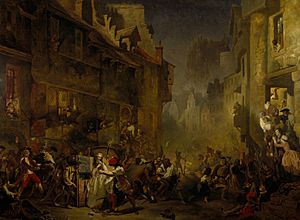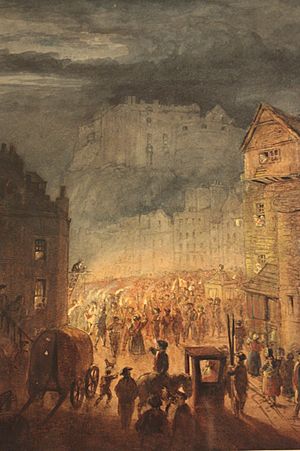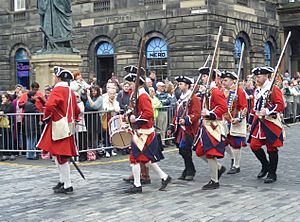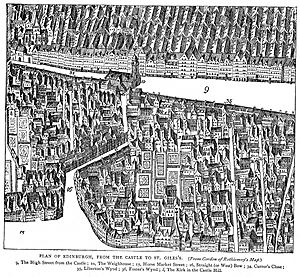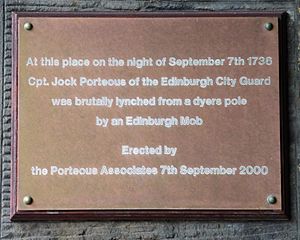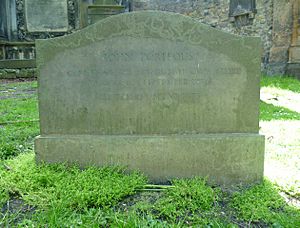Porteous Riots facts for kids
The Porteous Riots were a big event in Edinburgh, Scotland, in 1736. They involved Captain John Porteous, who was in charge of Edinburgh's City Guard. He was killed by a large crowd after he ordered his soldiers to shoot at people during a public hanging. This happened in a place called the Grassmarket. Even though the crowd supported the smugglers who were being hanged, Captain Porteous was not well-liked by many people in Edinburgh.
Contents
What Started the Riot?
In April 1736, three men were found guilty of smuggling. Their names were Andrew Wilson, William Hall, and George Robertson. They were sentenced to death. William Hall's sentence was changed, and he was sent away instead. But Wilson and Robertson stayed in the famous Tolbooth Prison. This prison was right next to St Giles Cathedral. A few days before they were to be executed, Wilson and Robertson tried to escape. Wilson, who was a very strong man, got stuck in the window, stopping Robertson from getting out.
On April 14, 1736, Andrew Wilson and George Robertson were publicly hanged in the Grassmarket. After Wilson's body was taken down, Captain Porteous of the City Guard reacted. He grabbed a gun and shot at a sailor. He missed the sailor but accidentally killed a man standing behind him in the crowd. Porteous then told his City Guards to fire into the angry crowd. This caused five more people to die.
During the chaos, Porteous, the hangman, and the city guards ran for safety. They went into the City Guardhouse on the Royal Mile. The situation got worse there. The city's leader, the Lord Provost of Edinburgh, told Captain Porteous to get all his guards ready. He also told them to have their guns loaded and to make sure the guardhouse was not attacked.
It's a bit unclear exactly what happened next. But Captain Porteous first told his soldiers to shoot over the heads of the crowd. However, this wounded people in the windows of nearby buildings. This made the crowd even more furious. As people panicked, Porteous ordered the City Guard to shoot directly into the crowd. This led to six more deaths. After this, the crowd moved back, and the streets became quiet.
Trial and Delay
Porteous was arrested that same afternoon. He was accused of murder. On July 5, 1736, he had his trial at the High Court of Justiciary. Many witnesses said they saw Porteous shoot into the crowd. However, sixteen other people said they did not see him do it. People in Edinburgh felt very strongly about the case. The jury decided that Porteous was guilty of murder. He was sentenced to death. His execution was planned for September 8, 1736, in the Grassmarket. Porteous was put in the same prison cell where Wilson and Robertson had been.
The government in London was worried about what was happening in Scotland. Sir Robert Walpole, a powerful leader, tried to get involved. But he didn't understand how strongly people in Scotland felt. A request was sent to Queen Caroline. She agreed to delay Porteous's execution.
Porteous's Death
People in Edinburgh became very angry when they heard that Porteous's execution was delayed. The city leaders increased the guards at the Tolbooth prison. They had heard there was a plan to kill the imprisoned Captain. But the night before the planned event, a crowd of over four thousand people gathered. They started west of the city and moved through the Grassmarket and Cowgate. They then went up to the High Street and gathered at the Tolbooth.
Eventually, the crowd managed to get past the guards. Porteous was pulled from his cell. He was dragged up the Lawnmarket to the West Bow and then down to the Grassmarket. There, he was killed by the mob.
He was buried the next day in Greyfriars Kirkyard, Edinburgh.
What Happened After?
The events in Edinburgh made the government in London even more worried. They were concerned about their control over Scotland. Prime Minister Robert Walpole, Queen Caroline, and the Duke of Newcastle thought Porteous had been unfairly sacrificed. There were even rumors that the city's leaders had been part of the plan.
In February 1737, a special meeting was held in the House of Lords. They first suggested getting rid of the City Guard. These ideas were later dropped. In the end, the city of Edinburgh had to pay a £2,000 fine. This money was given to Porteous's wife. Also, the city's leader, Lord Provost Alexander Wilson, was removed from his job.
Some people thought Porteous was killed by friends of those he had shot. Others thought it was revenge by smugglers. Some even thought it was a secret plot by certain groups. However, the way the event was organized suggests it was planned. It is thought that James Maxwell, a carpenter from Edinburgh, along with a small group of tradesmen, were behind it.
The government offered a reward of £200 for information. But the people responsible for Porteous's murder were never found.
Lasting Memory
For over two hundred years, John Porteous's grave in Greyfriars Kirkyard was marked by a small stone. It had only the letter "P" and the date 1736. More recently, a new headstone has been placed there. It says: "John Porteous, a captain of the City Guard of Edinburgh, murdered September 7, 1736. All Passion Spent, 1973."
Today, a special plate marks the spot in the Grassmarket where Porteous died. The place where the famous Tolbooth prison once stood is marked by paving stones shaped like a heart. This is known as the Heart of Midlothian. Even now, some people spit on this spot. This tradition started to show their dislike for the old Tolbooth prison.
The story of Porteous's death is also told in the novel The Heart of Midlothian by Sir Walter Scott. He wrote it in 1818.
See also
- John Porteous (soldier)
- Porteous family
- The Heart of Mid-Lothian (work by Sir Walter Scott)


